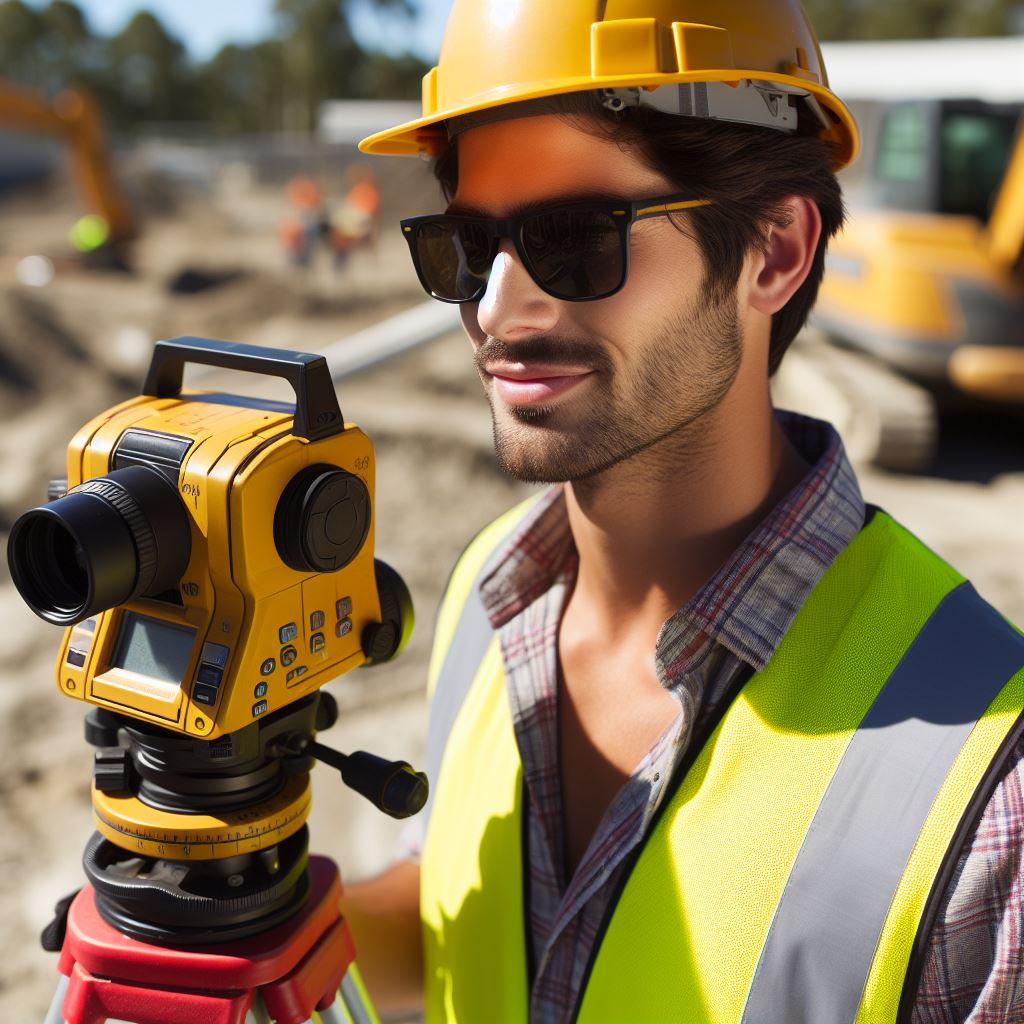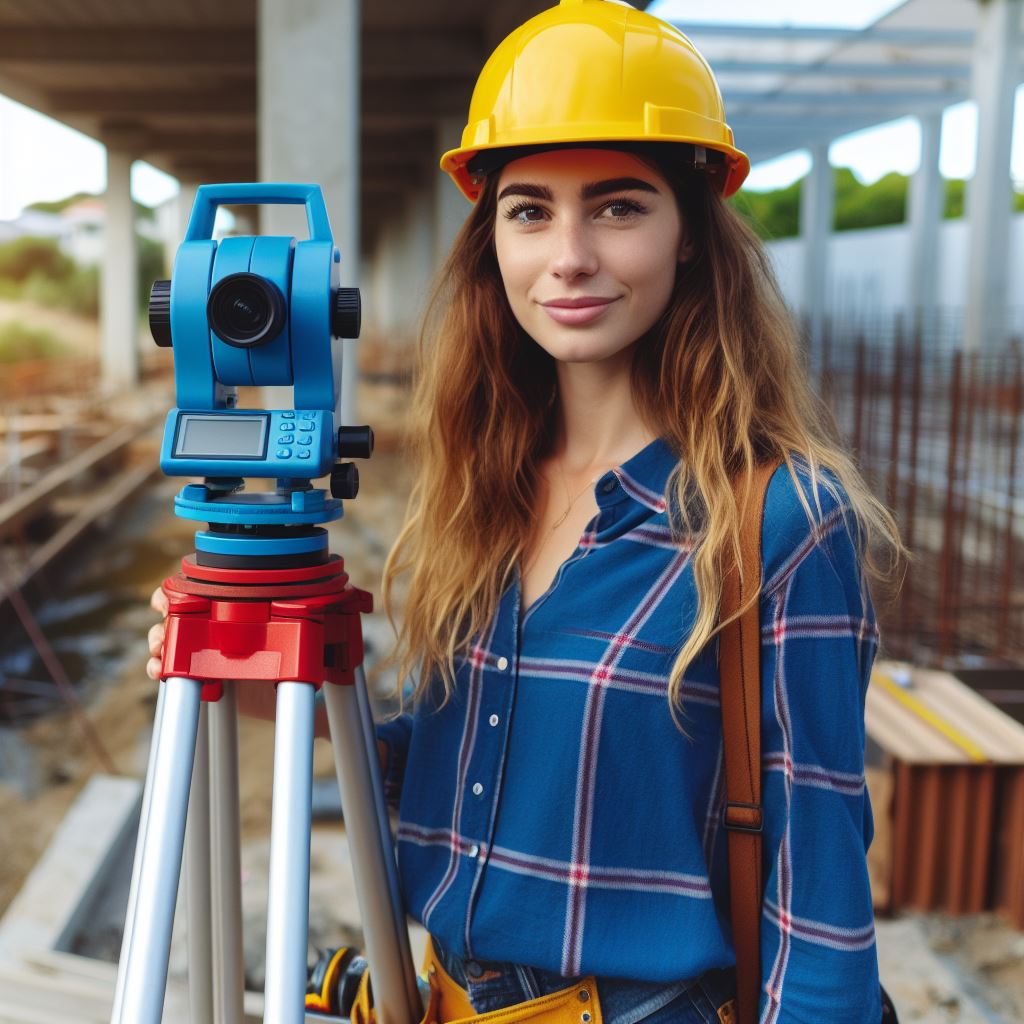Introduction
The topic of women in surveying in Australia is of great significance.
It is important to discuss the perspectives of women in this field in order to understand their experiences and challenges.
This blog post aims to shed light on the experiences and perspectives of women in surveying in Australia.
It will provide an overview of the topic and highlight the importance of this discussion.
The purpose of this post is to raise awareness, promote inclusivity, and inspire more women to pursue careers in surveying.
Surveying is a profession that involves the measurement, analysis, and mapping of land.
It plays a crucial role in various industries, including construction, engineering, and urban planning.
Despite its importance, women remain underrepresented in the field of surveying in Australia.
By discussing the perspectives of women in surveying, we can gain insight into the barriers they face and the strategies they employ to overcome them.
This will not only help us address gender inequality in the profession but also contribute to a more diverse and inclusive industry.
In the following sections, we will explore the experiences of women in surveying, highlighting their achievements, challenges, and the impact they have made in their respective fields.
Through these stories, we hope to inspire and empower the next generation of women in surveying in Australia.
Historical Context
In the past, various factors contributed to women’s underrepresentation in surveying.
Traditional gender roles and societal expectations imposed limitations on women’s involvement in the field.
Over time, significant milestones and changes have occurred, gradually expanding opportunities for women in surveying.
A. Factors Leading to Women’s Underrepresentation in Surveying
- Gender bias and discrimination perpetuated the belief that surveying was a male-dominated profession.
- Lack of educational opportunities for women denied them access to proper training and qualifications.
- Sexist attitudes and stereotypes regarding women’s physical abilities undermined their potential in surveying.
- The absence of female mentors and role models reinforced the perception that women couldn’t succeed in the field.
- Limited networking opportunities hindered women’s ability to gain employment and career advancement in surveying.
B. Gender Roles and Societal Expectations Restricting Women’s Involvement
- Historically, women were expected to fulfill domestic duties, leaving little room for pursuing careers outside the home.
- Stereotypes portrayed surveying as a physically demanding profession unsuitable for women.
- Social norms dictated that women should pursue more “feminine” careers instead of technical fields like surveying.
- Family responsibilities and childcare obligations often compelled women to prioritize their personal lives over professional aspirations.
- The lack of support systems and workplace policies accommodating working mothers further discouraged women from entering surveying.
C. Significant Milestones and Changes in Women’s Involvement
- During World War II, labor shortages led to some women taking on surveying roles, challenging gender norms.
- In the 1970s, feminist movements and equal opportunity laws raised awareness about gender inequality, including in surveying.
- The establishment of professional organizations and networks specifically for women in surveying provided support and mentorship.
- Advancements in technology and automation reduced physical labor, making surveying more accessible to women.
- Increased representation of women in leadership positions within surveying organizations has paved the way for further inclusion.
Despite the progress made, there are still hurdles to overcome in achieving full gender equality in surveying.
Women continue to face unconscious biases, wage gaps, and limited promotional opportunities.
However, efforts are being made to address these challenges.
Mentoring programs, scholarships, and awareness campaigns are being implemented to encourage more women to enter and thrive in the field.
By acknowledging the historical factors that hindered women’s involvement in surveying, we can better understand the importance of promoting diversity and inclusivity in the profession.
It is crucial to debunk stereotypes, challenge societal expectations, and provide equal opportunities for women to excel in surveying.
In essence, the historical context reveals the systemic barriers that limited women’s representation in surveying.
Despite these challenges, progress has been made, and it is essential to continue striving for gender equality in the field.
By creating an inclusive and supportive environment, the surveying profession can attract and retain talented women, contributing to the industry’s growth and innovation.
Current Landscape
A. Overview of the current situation for women in surveying in Australia
Women in the field of surveying in Australia face a challenging landscape in terms of representation and opportunities.
While progress has been made towards gender equality in various professions, surveying remains a predominantly male-dominated field.
B. Statistics and data on the representation of women in the field
Statistics and data reflect the significant gender gap in the surveying industry.
According to a report by the Australian Bureau of Statistics, only 14% of licensed surveyors in Australia are women.
This underrepresentation of women in the field further highlights the need for initiatives aimed at promoting diversity and inclusion.
C. Initiatives
One such initiative is the Women in Surveying Taskforce, established by the Surveying and Spatial Sciences Institute (SSSI) in collaboration with industry partners.
The taskforce aims to address the gender imbalance by providing support, resources, and networking opportunities for women in surveying.
It also strives to change the perception of surveying as a male-dominated field and encourage more women to pursue careers in this industry.
D. Programs aimed at promoting diversity and inclusion
The Surveying Sisterhood mentoring program actively fosters diversity, pairing experienced female surveyors with early-career professionals for guidance and skill development.
SSSI conducts awareness campaigns challenging stereotypes and advocating for women’s inclusion in surveying.
Universities offer scholarships and grants to attract and retain women in surveying programs, addressing existing challenges.
Despite obstacles, stories of successful women breaking barriers inspire future generations in surveying careers.
The industry must continue promoting diversity, providing equal opportunities, and benefiting from a broader talent pool.
Efforts, like the Women in Surveying Taskforce and mentoring programs, aim to bridge the gender gap.
With continued awareness and initiatives, the surveying industry can evolve into a more inclusive and equal profession.
Challenges and Barriers
A. Identifying the Main Challenges and Barriers Faced by Women in Surveying
- Lack of representation in leadership positions.
- Gender pay gap and unequal opportunities for career advancement.
- Hostile work environment and lack of support from male colleagues.
- Unconscious bias in hiring and promotion processes.
- Limited access to training and development opportunities.
B. Gender Bias, Stereotypes, and Discrimination
- Prevalence of stereotypes that assume women are not suited for physically demanding fieldwork.
- Perceived lack of confidence and assertiveness which can hinder career progression.
- Instances of sexual harassment and discrimination based on gender identity.
- Expectations to conform to traditional gender roles and behave in a feminine manner.
- Negative assumptions about women’s technical capabilities and decision-making skills.
C. The Impact of Work-Life Balance and Family Responsibilities on Women’s Career Progression
- Pressure to prioritize family obligations over career advancement.
- Inadequate support for parental leave and flexible work arrangements.
- Difficulties in balancing demanding fieldwork and childcare or household responsibilities.
- Limited availability of childcare options during fieldwork assignments or long hours.
- Lack of understanding and accommodation from employers towards work-life balance needs.
Read: Surveying 101: An Aussie’s Intro to the Field
Success Stories and Role Models
Women in the surveying industry have made significant contributions and achieved great milestones, becoming inspiring success stories and role models for aspiring women in this field.
A. Inspiring Stories of Successful Women in the Surveying Industry
- Jane Adams, a renowned surveyor, started her own successful surveying company and has been instrumental in several high-profile infrastructure projects.
- Rebecca Carter, despite facing gender biases early in her career, persevered and now leads a team of skilled surveyors, consistently delivering exceptional results.
- Alyssa Davis overcame various challenges and became the first female surveyor to receive the prestigious Surveying Excellence Award.
These women have demonstrated exceptional skills, resilience, and determination, paving the way for future generations of female surveyors.
B. Achievements and Contributions
- Emily Brown played a crucial role in the development of a state-of-the-art mapping system, revolutionizing the way surveys are conducted.
- Stephanie Lee’s expertise in land surveying has been instrumental in resolving complex property disputes and ensuring fair land divisions.
- Lisa Mitchell’s innovative approach to surveying has significantly improved the accuracy and efficiency of data collection processes.
These notable female surveyors have left a lasting impact on the industry through their groundbreaking achievements and invaluable contributions.
C. The Importance of Having Role Models for Aspiring Women in the Field
Having role models is crucial for aspiring women in the surveying industry, as they provide inspiration, guidance, and the confidence to pursue their goals.
- Role models showcase that success in the surveying industry is attainable regardless of gender, encouraging women to overcome any perceived barriers.
- They serve as mentors, offering valuable advice and sharing their experiences, helping aspiring women navigate their career paths more effectively.
- Role models also help challenge stereotypes and promote diversity within the industry, leading to increased gender representation and inclusivity.
Through the stories and achievements of successful women in surveying, aspiring female surveyors can envision their own path to success and find the motivation to pursue their dreams.
It is crucial to celebrate and highlight the accomplishments of women in surveying, as they inspire future generations of women to enter and excel in the field.
Recognize notable female surveyors’ contributions. Foster an empowering environment. Encourage women to choose surveying, a fulfilling career.
Your Personalized Career Strategy
Unlock your potential with tailored career consulting. Get clear, actionable steps designed for your success. Start now!
Get StartedIt is through the continuous efforts of individuals, organizations, and the industry as a whole that we can ensure equal opportunities and representation for women in surveying.
Read: Historic Preservation in Australian Architecture

Find Out More: The Role of Surveyors in Aussie Construction
Efforts for Change
A. Explore ongoing efforts to address gender disparities in surveying
Gender disparities in the field of surveying have long been recognized and efforts are being made to address them.
Various organizations, associations, and government initiatives have come together to work towards achieving equitable representation for women in surveying.
B. Organizations, associations, and government initiatives working towards equitable representation
Many organizations, associations, and government initiatives have taken up the challenge of promoting gender equality in surveying.
These entities recognize the importance of diversity and are actively involved in creating opportunities for women in this field.
C. Policies or practices that have been implemented to create a more inclusive environment
Several policies and practices have been implemented to create a more inclusive environment for women in surveying.
These include mentoring programs, scholarships, networking events, and educational campaigns to encourage and support women in pursuing careers in this field.
1. Organizations
Women in Surveying Network (WiSN)
WiSN was established to support and promote women working in surveying.
They provide networking opportunities, mentorship programs, and resources for professional development.
Women in Spatial
Women in Spatial is a network that aims to increase the representation of women in all spatial disciplines, including surveying.
They advocate for gender equality and provide a platform for women to connect and share their experiences.
Association of Licensed Surveyors (ALSA)
ALSA is committed to promoting diversity and inclusion in the surveying profession.
They organize workshops, seminars, and conferences to discuss challenges faced by women and work towards finding solutions.
2. Government Initiatives
Workplace Gender Equality Agency (WGEA)
The WGEA is an Australian government agency that promotes and improves gender equality in workplaces.
They work closely with organizations to address gender disparities and support initiatives that encourage women’s participation in surveying.
National Association of Women in Construction (NAWIC)
Although not specifically focused on surveying, NAWIC actively supports women in traditionally male-dominated industries, including construction and surveying.
They provide educational programs, mentoring opportunities, and advocacy for women’s career advancement.
3. Policies and Practices
Flexible work arrangements
Many organizations in the surveying industry have implemented flexible work arrangements to accommodate the needs of women, such as remote work, job sharing, and flexible working hours.
Workforce diversity targets
Some organizations have set specific targets for increasing the representation of women in surveying.
These targets help to measure progress and hold organizations accountable for achieving gender equality.
Stand Out with a Resume That Gets Results
Your career is worth more than a generic template. Let us craft a resume and cover letter that showcase your unique strengths and help you secure that dream job.
Get HiredMentorship programs
Mentorship programs have proven to be effective in supporting women’s career advancement.
These programs pair experienced professionals with aspiring women surveyors, providing guidance and support.
Educational campaigns
Educational campaigns are aimed at inspiring young girls to consider surveying as a career option.
By challenging stereotypes and promoting the benefits of a career in surveying, these campaigns encourage more women to pursue this field.
In summary, significant efforts are being made to address gender disparities in surveying.
Organizations, associations, and government initiatives are working towards equitable representation and implementing policies and practices to create a more inclusive environment.
Through these collective endeavors, the surveying industry is gradually becoming more diverse and welcoming for women.
Read: Challenges Faced by Modern Architects
Learn More: Surveying Laws in Australia: A Guide
Discover More: The Role of AI in Australian Civil Engineering
Personal Perspectives
Embark on an insightful journey into the world of surveying through the personal perspectives of women who are leaving an indelible mark on the industry.
This section aims to amplify their voices, allowing for an intimate exploration of their experiences, challenges, and remarkable achievements.
A. Anecdotes Unfolded: Personal Stories, Shared Wisdom
In the heart of our narrative are personal anecdotes, offering a unique window into the lives of women actively engaged in surveying.
These women illuminate their professional journeys, sharing pivotal moments, offering firsthand insights into challenges, and revealing triumphs that shaped their careers.
B. Navigating Challenges: Triumphs of Tenacity
In the candid discussions that unfold, these women recount the challenges they’ve encountered in the surveying realm.
From gender biases to breaking through glass ceilings, each narrative is a testament to the tenacity required to overcome hurdles.
Readers gain valuable insights into how these women navigated obstacles, fostering resilience and determination.
C. Celebrating Achievements: Milestones and Beyond
This section is also a celebration of achievements.
These women have not only overcome challenges but have excelled in various facets of surveying.
From pioneering projects to introducing innovative methodologies, their accomplishments stand as beacons of inspiration, proving that gender is no barrier to success in the field.
D. Diverse Voices, Unified Passion
Our platform serves as a stage for diverse voices, showcasing the breadth of roles and experiences within the surveying profession.
From urban planning to geospatial analysis, each woman’s perspective adds a layer to the collective narrative, enriching the overall tapestry of surveying with their unique insights.
E. Empowering Through Shared Narratives
Beyond personal anecdotes, this initiative seeks to empower both current and aspiring surveyors.
By sharing stories that resonate, we hope to create a sense of community and inspiration.
These narratives not only foster understanding but also provide role models for those navigating the dynamic landscape of surveying.
Transform Your LinkedIn for Maximum Impact
Elevate your professional brand with a LinkedIn profile that attracts recruiters, showcases your expertise, and maximizes opportunities. Stand out in your industry with a profile built for success.
Boost ProfileF. Readers’ Takeaway: A Mosaic of Perspectives
For readers, this section is an invitation to immerse themselves in a mosaic of perspectives.
The diverse voices and experiences showcased here offer a comprehensive view of the surveying profession.
It is an opportunity to broaden one’s understanding, challenge stereotypes, and appreciate the myriad ways in which women contribute to shaping our physical and social environments.
Essentially, “Personal Perspectives: Women in Surveying” is a tribute to the resilience, achievements, and diversity of women in the field.
Through personal anecdotes and interviews, we aim to provide a platform that not only informs but also inspires, creating a lasting impact on the narrative surrounding women in surveying.
Read: Architecture Licensing in Australia Explained
Conclusion
This blog post has highlighted the experiences and perspectives of women in the field of surveying in Australia.
It has emphasized the challenges they face, such as gender biases and lack of representation, but also celebrated their contributions and successes.
It is clear that empowering and supporting women in surveying is crucial for the growth and development of the profession.
Efforts must be made to break down barriers and create equal opportunities for women to thrive in this field.
To aspiring women interested in surveying, remember that your gender does not define your abilities or limit your potential.
Have confidence in your skills, seek mentorship and support, and continue to pursue your passion.
The field of surveying needs your unique perspectives and contributions.
In the end, let us continue to champion gender equality, empower women in surveying, and create a more diverse and inclusive profession for all.
Together, we can create a brighter future for women in surveying.




